Power Grid Reliability Evaluation Considering Wind Farm Cyber Security and Ramping Events
Abstract
:1. Introduction
2. Wind Farm Cyber Architecture and Security Risks
3. Attack–Defense Model of Vulnerability
3.1. Stochastic Model Based on MTTC
3.2. System Defense Model
4. Attack Scenarios
4.1. Worst-Case Attack of Wind Turbines
4.2. Long-Term Imperfect Attack of Wind Turbine
5. Power System Reliability Assessment
5.1. Modeling of Wind Power and WPRs
5.2. Bi-Level Modeling of the Worst-Case Attack
5.3. The Procedures of Reliability Assessment
6. Case Studies and Results
6.1. Reliability Assessment Considering Worst-Case Attack
6.1.1. Impact Analysis of Worst-Case Attack
6.1.2. The Composite Reliability Assessment
6.2. Reliability Assessment with the Imperfect Attack
7. Conclusions
Author Contributions
Funding
Conflicts of Interest
References
- GLOBAL STATUS OVERVIEW GWEC. Available online: https://gwec.net/global-figures/wind-energy-global-status/ (accessed on 17 February 2019).
- Lai, J.; Duan, B.; Su, Y.; Li, L.; Yin, Q. An active security defense strategy for wind farm based on automated decision. In Proceedings of the 2017 IEEE Power Energy Society General Meeting, Chicago, IL, USA, 16–20 July 2017; pp. 1–5. [Google Scholar]
- Falahati, B.; Kahrobaee, S.; Ziaee, O.; Gharghabi, P. Evaluating the differences between direct and indirect interdependencies and their impact on reliability in cyber-power networks. In Proceedings of the 2017 IEEE Conference on Technologies for Sustainability (SusTech), Phoenix, AZ, USA, 12–14 November 2017; pp. 1–6. [Google Scholar]
- Han, Y.; Wen, Y.; Guo, C.; Huang, H. Incorporating Cyber Layer Failures in Composite Power System Reliability Evaluations. Energies 2015, 8, 9064–9086. [Google Scholar] [CrossRef] [Green Version]
- Huang, L.; Fu, Y.; Mi, Y.; Cao, J.; Wang, P. A Markov-Chain-Based Availability Model of Offshore Wind Turbine Considering Accessibility Problems. IEEE Trans. Sustain. Energy 2017, 8, 1592–1600. [Google Scholar] [CrossRef]
- Mitchell, R.; Chen, I. Modeling and Analysis of Attacks and Counter Defense Mechanisms for Cyber Physical Systems. IEEE Trans. Reliab. 2016, 65, 350–358. [Google Scholar] [CrossRef]
- Zhang, Y.; Wang, L.; Xiang, Y.; Ten, C.W. Power System Reliability Evaluation with SCADA Cybersecurity Considerations. IEEE Trans. Smart Grid 2015, 6, 1707–1721. [Google Scholar] [CrossRef]
- Chen, Y.; Li, Y.; Li, W.; Wu, X.; Cai, Y.; Cao, Y.; Rehtanz, C. Cascading Failure Analysis of Cyber Physical Power System with Multiple Interdependency and Control Threshold. IEEE Access 2018, 6, 39353–39362. [Google Scholar] [CrossRef]
- Kateb, R.; Tushar, M.H.K.; Assi, C.; Debbabi, M. Optimal Tree Construction Model for Cyber-Attacks to Wide Area Measurement Systems. IEEE Trans. Smart Grid 2018, 9, 25–34. [Google Scholar] [CrossRef]
- Zhang, Y.; Wang, L.; Sun, W. A preliminary study of power system reliability evaluation considering cyber attack effects. In Proceedings of the 2013 IEEE Power Energy Society General Meeting, Vancouver, BC, Canada, 21–25 July 2013; pp. 1–5. [Google Scholar]
- Johnson, P.; Lagerstrom, R.; Ekstedt, M.; Franke, U. Can the Common Vulnerability Scoring System be Trusted? A Bayesian Analysis. IEEE Trans. Dependable Secur. Comput. 2016, 15, 1002–1015. [Google Scholar] [CrossRef]
- Nzoukou, W.; Wang, L.; Jajodia, S.; Singhal, A. A Unified Framework for Measuring a Network’s Mean Time-to-Compromise. In Proceedings of the 2013 IEEE 32nd International Symposium on Reliable Distributed Systems, Braga, Portugal, 30 September–3 October 2013; pp. 215–224. [Google Scholar]
- Kapourchali, M.H.; Sepehry, M.; Aravinthan, V. Fault Detector and Switch Placement in Cyber-Enabled Power Distribution Network. IEEE Trans. Smart Grid 2018, 9, 980–992. [Google Scholar] [CrossRef]
- Staggs, J.; Ferlemann, D.; Shenoi, S. Wind farm security: Attack surface, targets, scenarios and mitigation. Int. J. Crit. Infrastruct. Prot. 2017, 17, 3–14. [Google Scholar] [CrossRef]
- Yan, J.; Liu, C.C.; Govindarasu, M. Cyber intrusion of wind farm SCADA system and its impact analysis. In Proceedings of the 2011 IEEE/PES Power Systems Conference and Exposition, Phoenix, AZ, USA, 20–23 March 2011; pp. 1–6. [Google Scholar]
- Zhang, Y.; Xiang, Y.; Wang, L. Power System Reliability Assessment Incorporating Cyber Attacks Against Wind Farm Energy Management Systems. IEEE Trans. Smart Grid 2017, 8, 2343–2357. [Google Scholar] [CrossRef]
- Cui, M.; Feng, C.; Wang, Z.; Zhang, J. Statistical Representation of Wind Power Ramps Using a Generalized Gaussian Mixture Model. IEEE Trans. Sustain. Energy 2018, 9, 261–272. [Google Scholar] [CrossRef]
- Qi, Y. Wind Power Ramping Control Using Competitive Game. IEEE Trans. Sustain. Energy 2016, 7, 9. [Google Scholar] [CrossRef]
- Gong, Y.; Chung, C.Y.; Mall, R.S. Power System Operational Adequacy Evaluation with Wind Power Ramp Limits. IEEE Trans. Power Syst. 2018, 33, 2706–2716. [Google Scholar] [CrossRef]
- Mohammadpourfard, M.; Sami, A.; Weng, Y. Identification of False Data Injection Attacks with Considering the Impact of Wind Generation and Topology Reconfigurations. IEEE Trans. Sustain. Energy 2017, 9, 1349–1364. [Google Scholar] [CrossRef]
- Mell, P.; Scarfone, K.; Romanosky, S. Common Vulnerability Scoring System. IEEE Secur. Priv. 2006, 4, 85–89. [Google Scholar] [CrossRef]
- Jonsson, E. A Quantitative Model of the Security Intrusion Process Based on Attacker Behavior. IEEE Trans. Softw. Eng. 1997, 23, 235–245. [Google Scholar] [CrossRef]
- Ghirmai, T. Laplace Autoregressive Model for Cascaded Systems. IEEE Trans. Syst. Man Cybern. Syst. 2016, 46, 771–781. [Google Scholar] [CrossRef]
- Verizon. 2017 Data Breach Investigations Report, Verizon Enterprise Solutions, Investigations Report; Verizon: New York, NY, USA, 2017; p. 10. [Google Scholar]
- Falliere, N.; Murchu, L.; Chien, E. W32.Stuxnet Dossier. Symantec Secur. Response 2011, 5, 1–68. [Google Scholar]
- Ribrant, J.; Bertling, L.M. Survey of Failures in Wind Power Systems with Focus on Swedish Wind Power Plants During 1997–2005. IEEE Trans. Energy Convers. 2007, 22, 167–173. [Google Scholar] [CrossRef]
- Tautz-Weinert, J.; Watson, S.J. Using SCADA data for wind turbine condition monitoring a review. IET Renew. Power Gener. 2017, 11, 382–394. [Google Scholar] [CrossRef]
- Wysoclci, A.; Feest, B. Bearing Failure: Causes and Cures; ECM Electrical Construction Maintenance: Perth, Australia, 1997. [Google Scholar]
- Nguyen, K.T.P.; Fouladirad, M.; Grall, A. New Methodology for Improving the Inspection Policies for Degradation Model Selection According to Prognostic Measures. IEEE Trans. Reliab. 2018, 67, 1269–1280. [Google Scholar] [CrossRef] [Green Version]
- Sumereder, C. Stat. lifetime of hydro generators and failure analysis. IEEE Transactions Dielectr. Electr. Insul. 2008, 15, 678–685. [Google Scholar] [CrossRef]
- Cui, M.; Zhang, J.; Florita, A.R.; Hodge, B.; Ke, D.; Sun, Y. An Optimized Swinging Door Algorithm for Identifying Wind Ramping Events. IEEE Trans. Sustain. Energy 2016, 7, 150–162. [Google Scholar] [CrossRef]
- Subcommittee, P.M. IEEE Reliability Test System. IEEE Trans. Power Appar. Syst. 1979, PAS-98, 2047–2054. [Google Scholar] [CrossRef]
- Draxl, C.; Clifton, A.; Hodge, B.M.; McCaa, J. The Wind Integration National Dataset (WIND) Toolkit. Appl. Energy 2015, 151, 355–366. [Google Scholar] [CrossRef] [Green Version]
- Bearings for Wind Turbines. Available online: https://anagnostou-sa.gr/wp-content/uploads/2017/06/URB-Wind-Bearings.pdf (accessed on 9 August 2018).

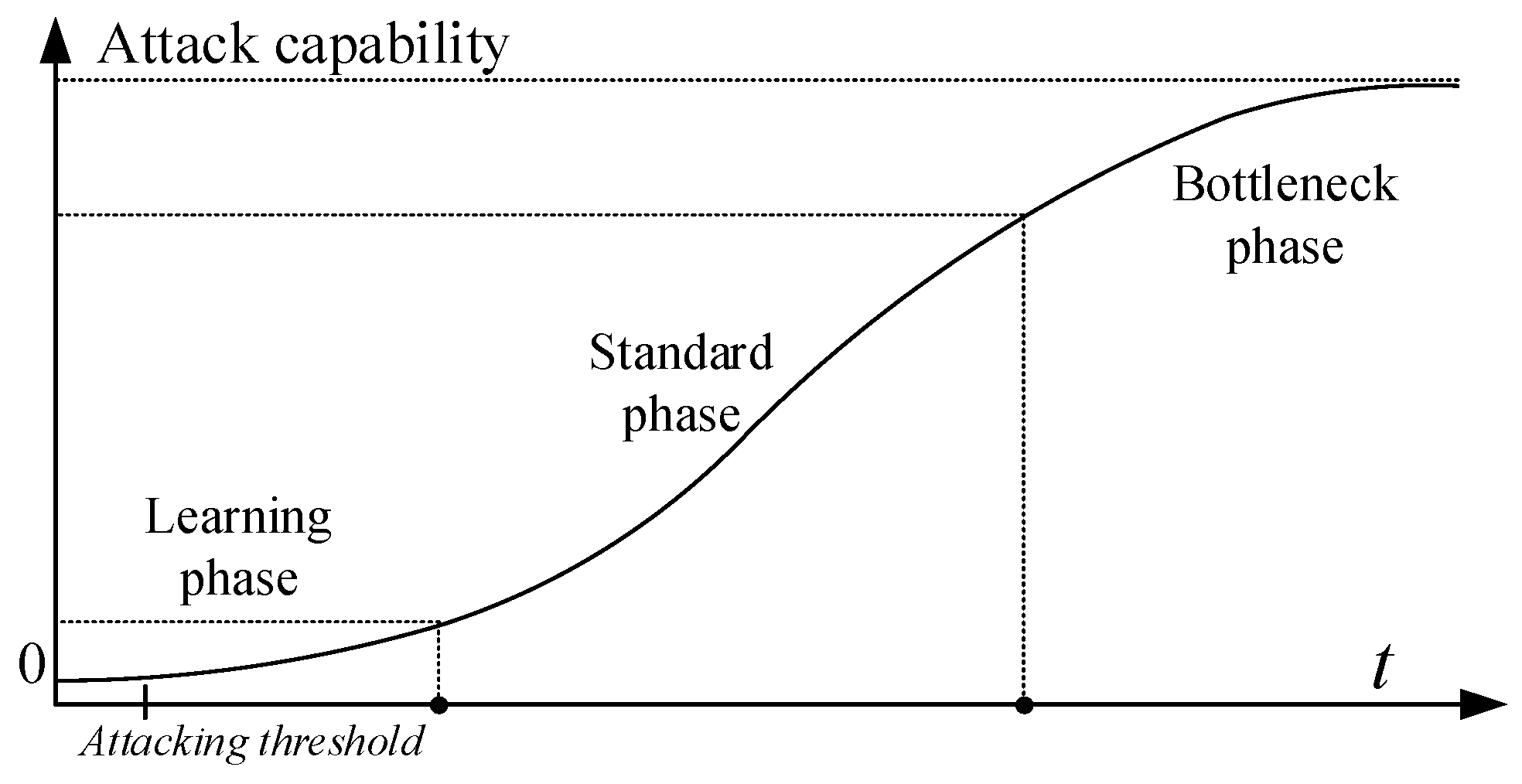

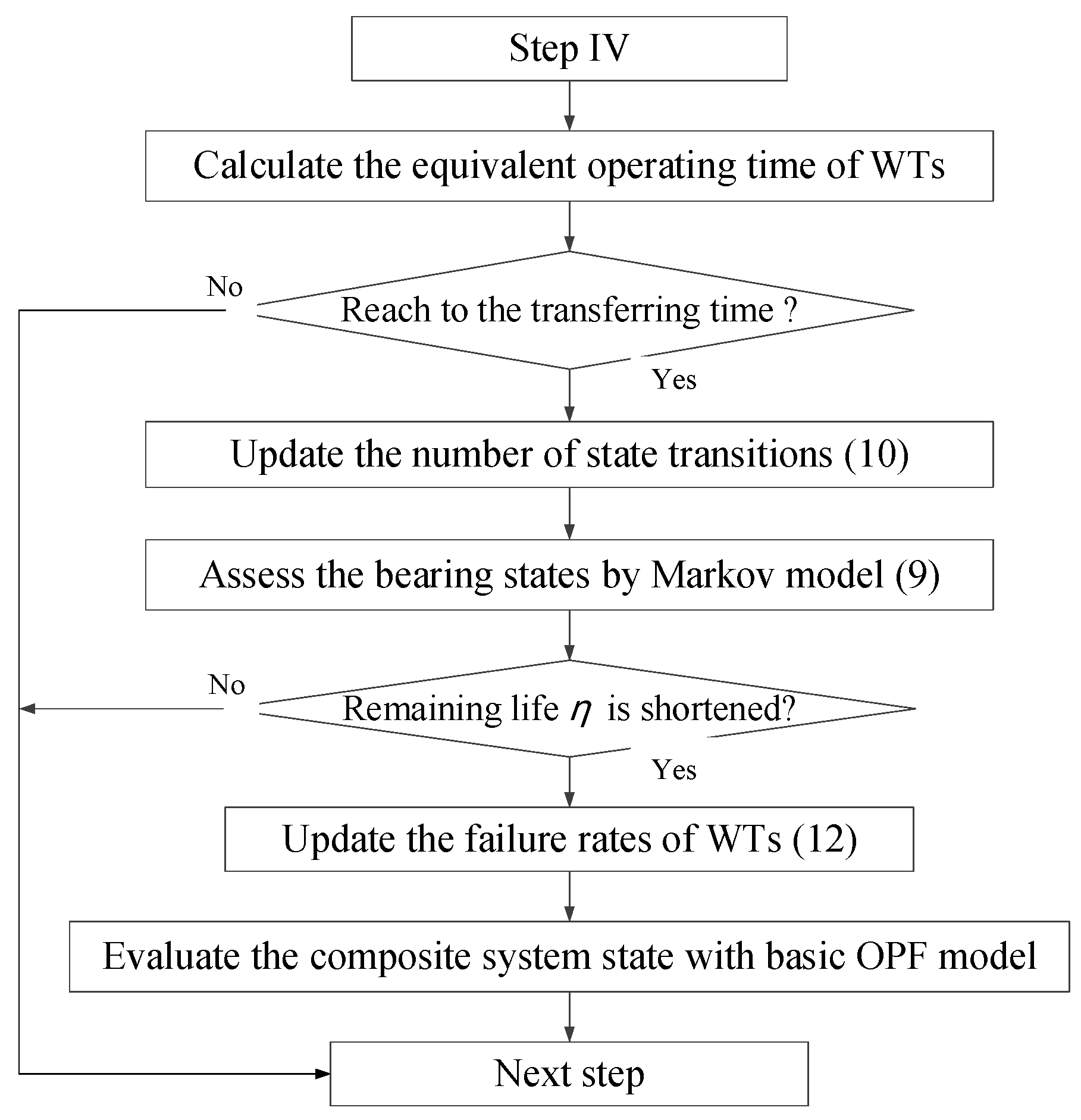
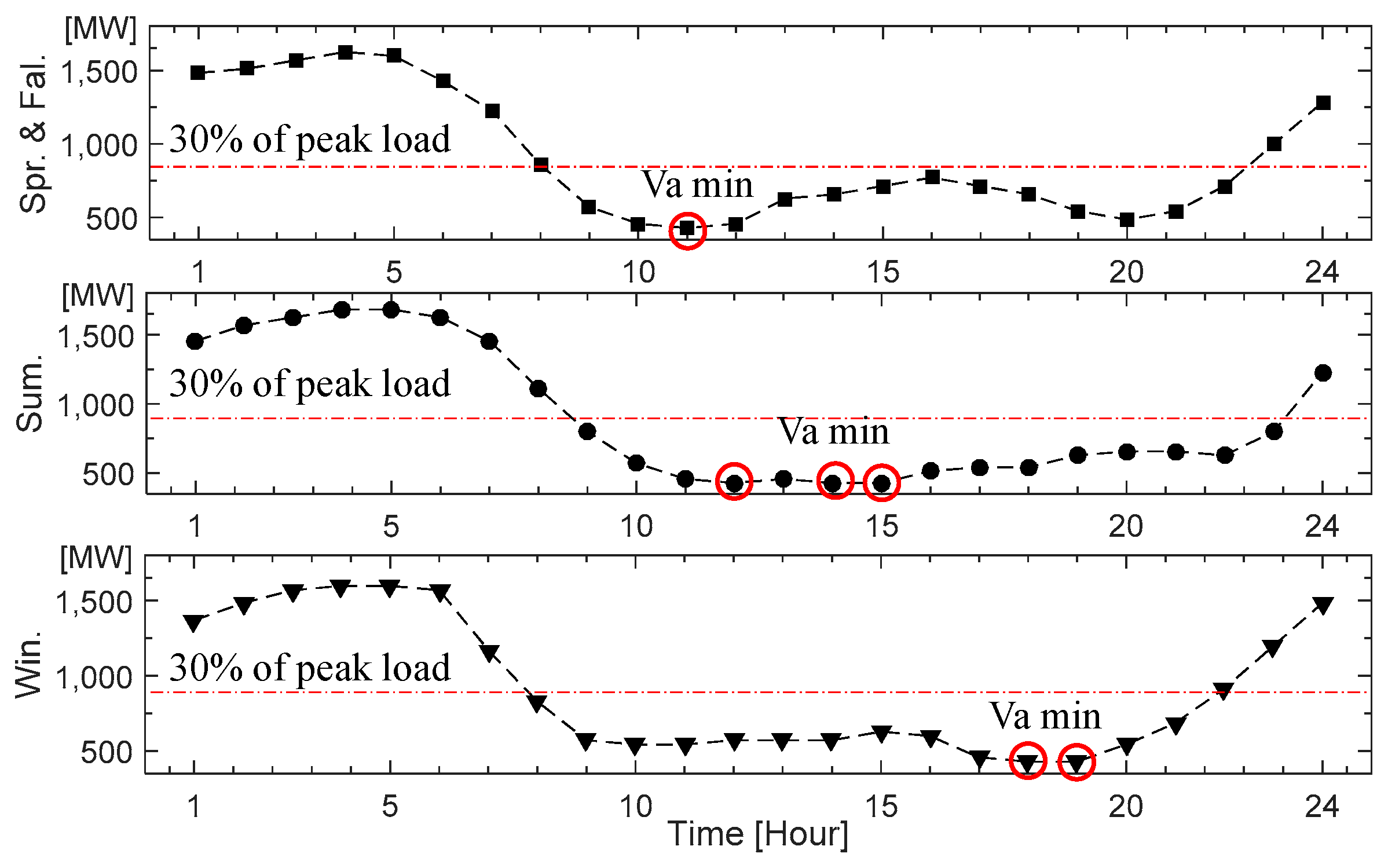
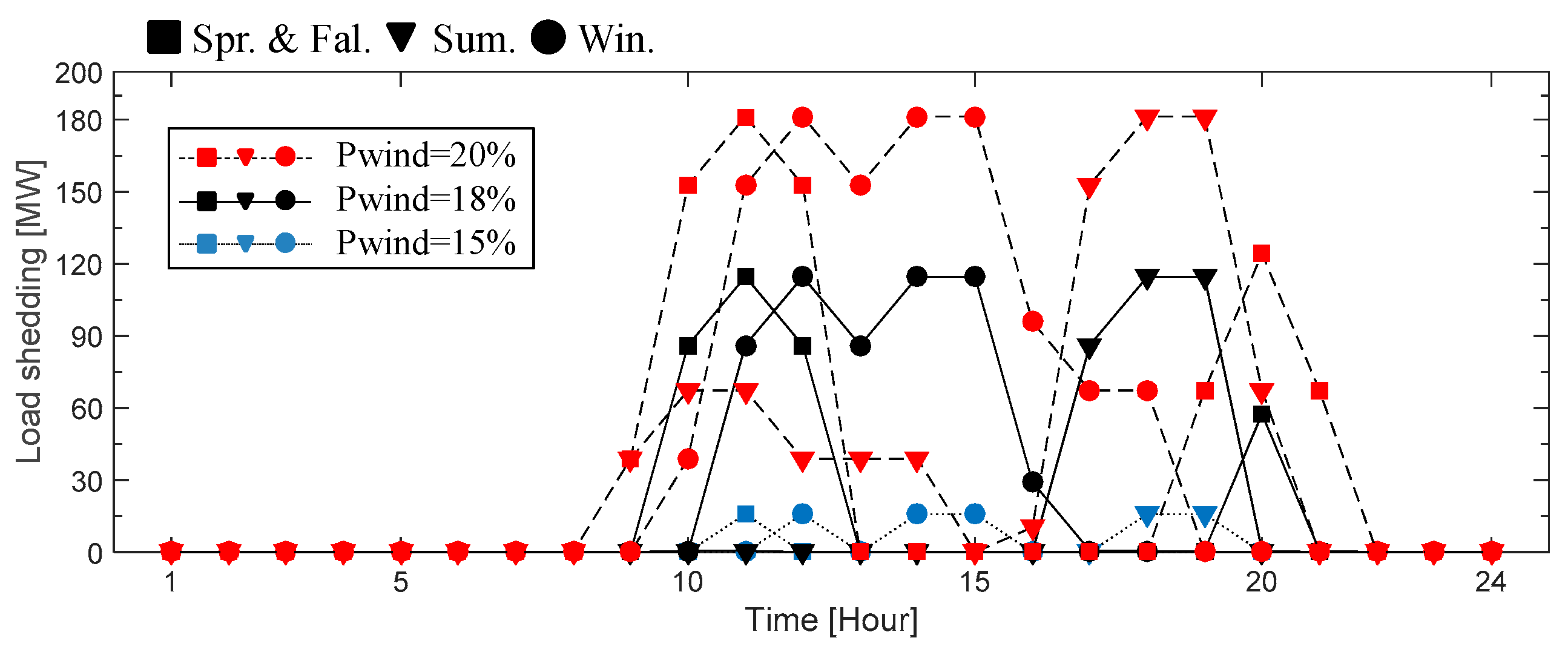
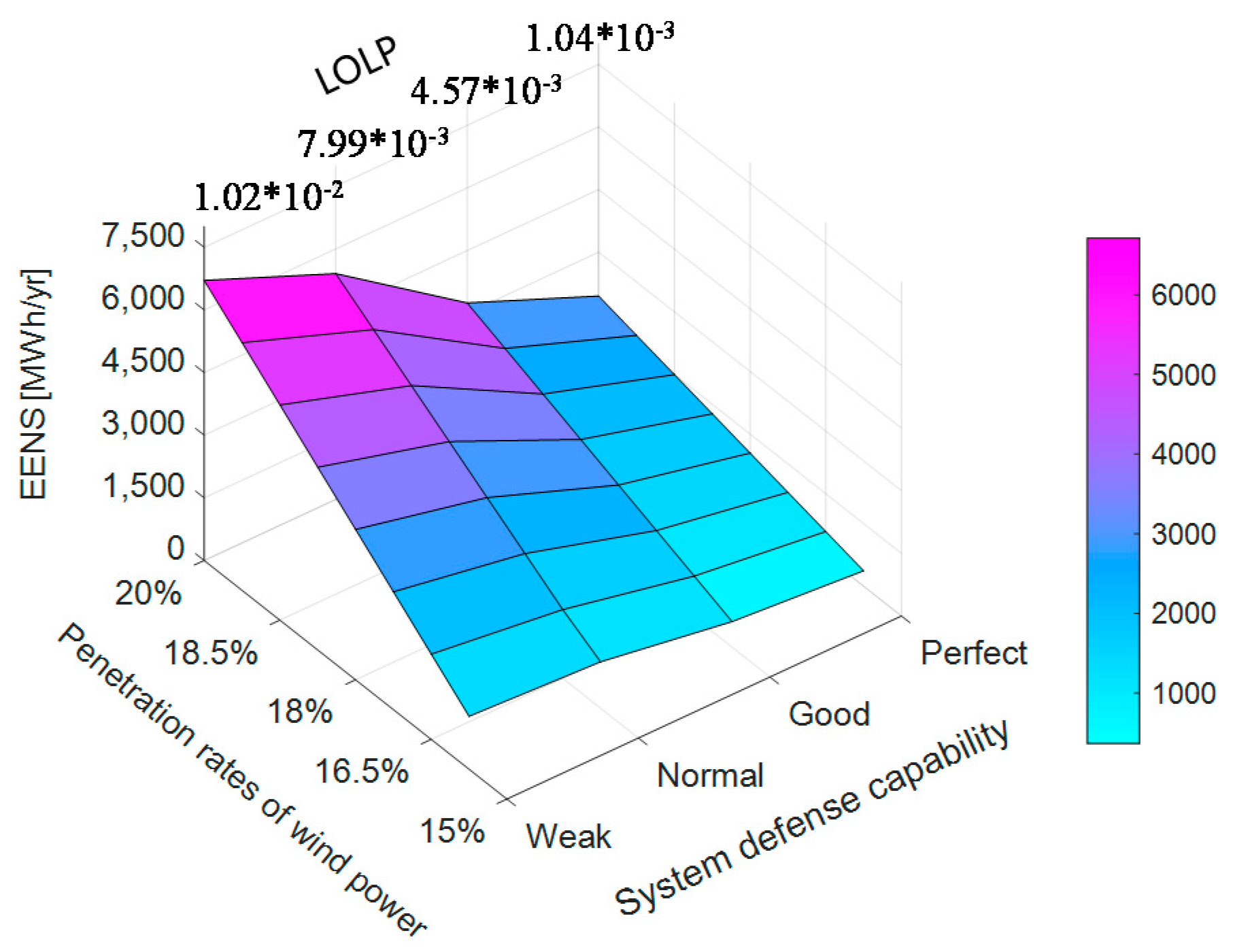
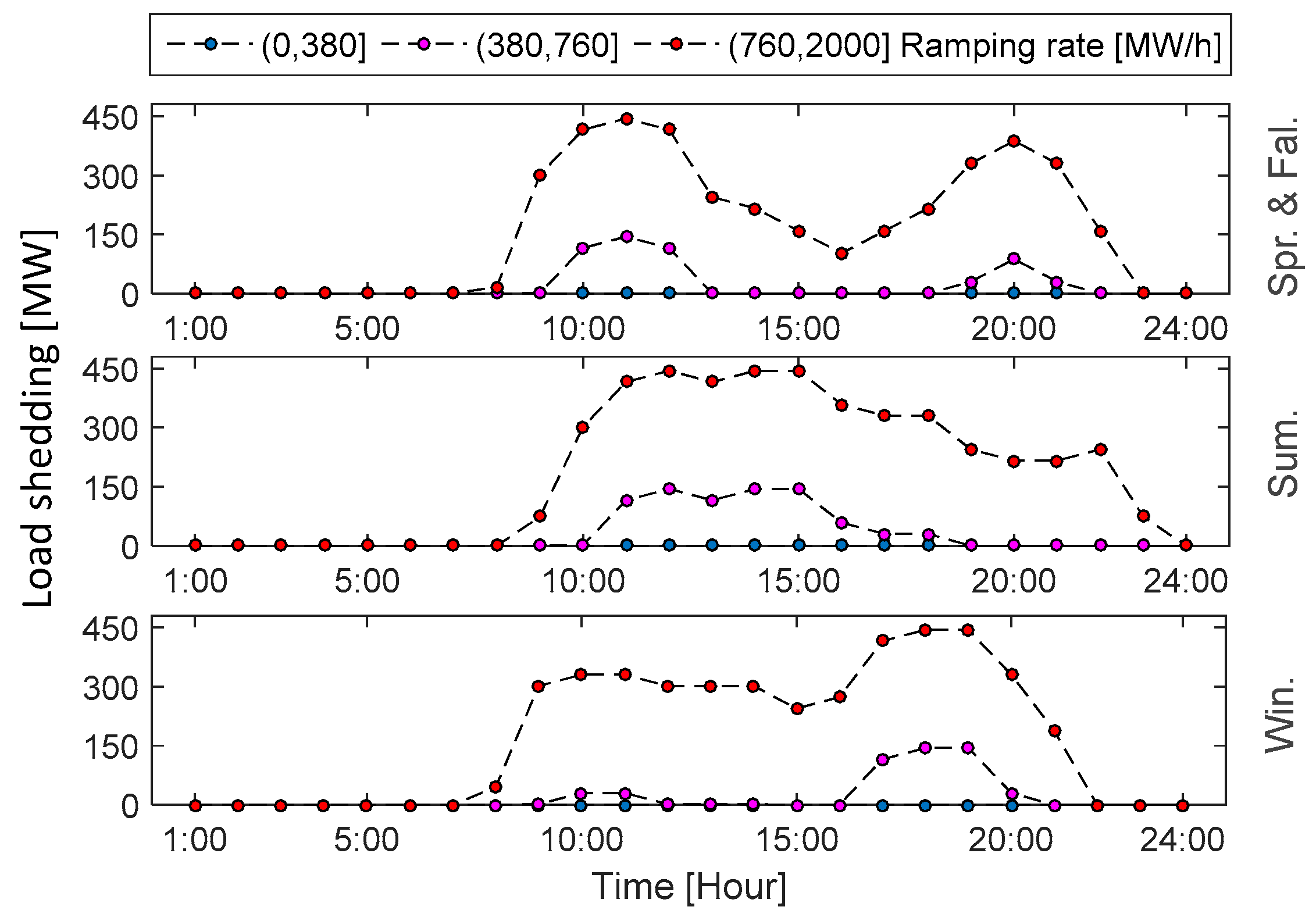

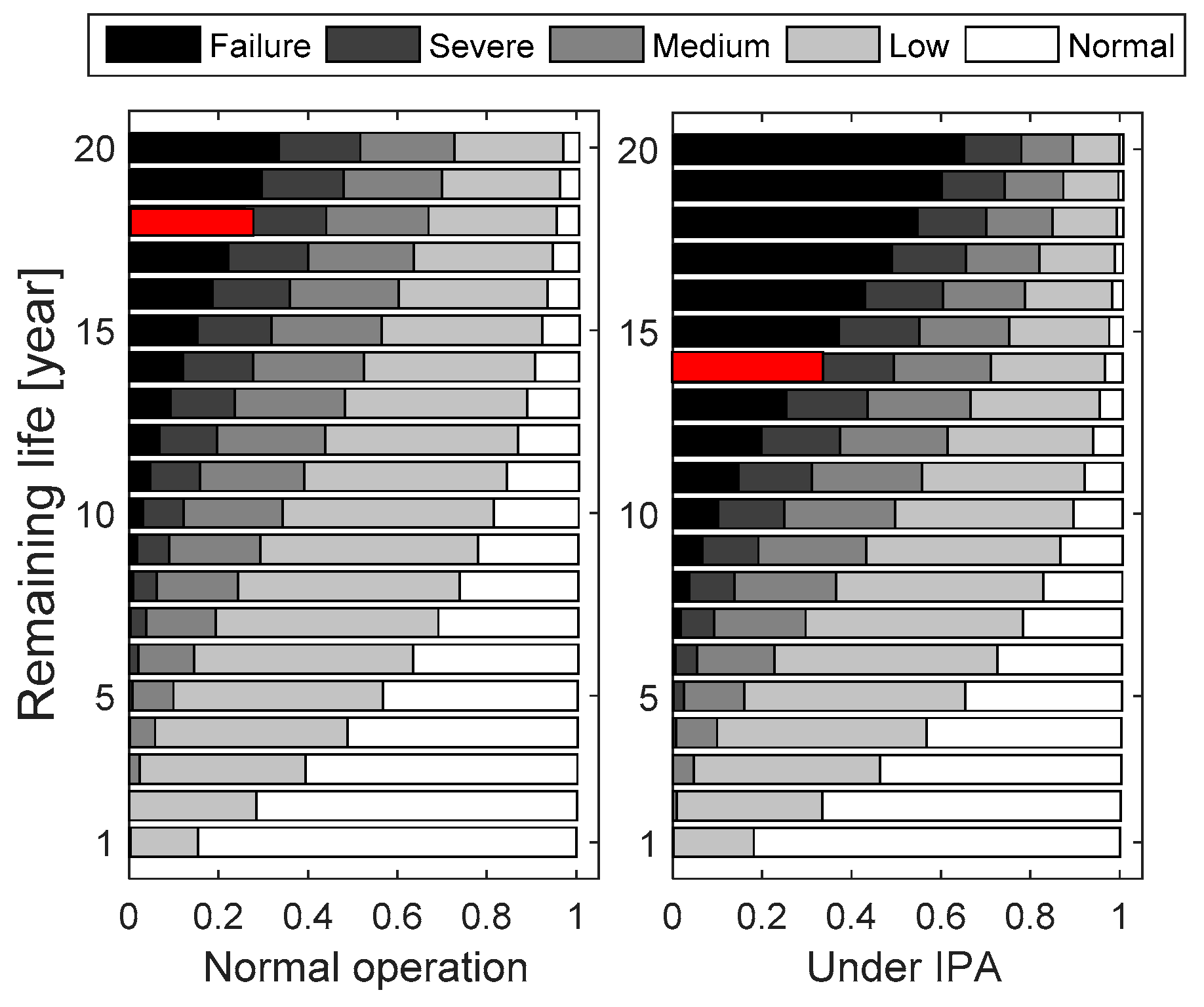
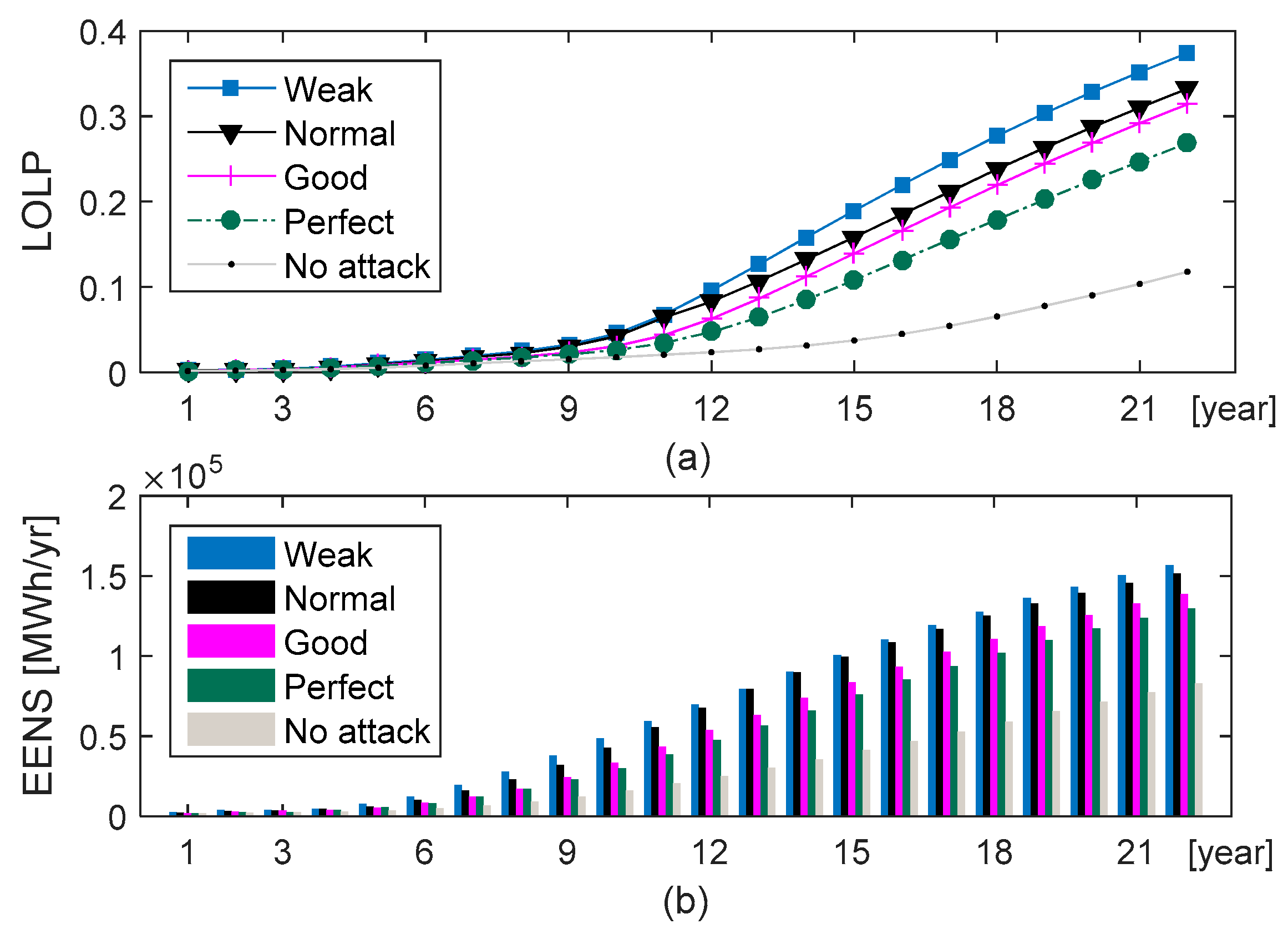
| Defense Capability | α0 | α1 | α2 | β |
|---|---|---|---|---|
| Weak | 0 | 0 | 0.2 | 0.8 |
| Normal | 0 | 0.2 | 0.2 | 0.6 |
| Good | 0.2 | 0.3 | 0.4 | 0.1 |
| Perfect | 0.7 | 0.2 | 0.1 | 0 |
| DC | 0 < t ≤ 7 | 7 < t ≤ 28 | 28 < t ≤ 84 | 84 < t ≤ 365 | PM |
|---|---|---|---|---|---|
| Weak | 0.245 | 0.088 | 0.235 | 0.254 | 0.010 |
| Normal | 0.245 | 0.070 | 0.176 | 0.190 | 0.008 |
| Good | 0.020 | 0.044 | 0.029 | 0.032 | 0.004 |
| Perfect | 0.007 | 0.088 | 0 | 0 | 0.001 |
| Bearing Conditions | Wear Interval |
|---|---|
| SN: Normal | (0~0.2) Δmax |
| SL: Low | (0.2~0.4) Δmax |
| SM: Medium | (0.4~0.7) Δmax |
| SS: Severe | (0.7~1.0) Δmax |
| SF: Failure | >Δmax |
| No. | Event | LOLP | EENS [MWh/yr] |
|---|---|---|---|
| 1 | SF | 4.09 × 10−3 | 1.68 × 10+3 |
| 2 | SA | 7.99 × 10−3 | 1.11 × 10+3 |
| 3 | SR | 3.20 × 10−3 | 4.04 × 10+3 |
| 4 | SR∪SA | 3.28 × 10−3 | 6.08 × 10+3 |
| 5 | SA∪SF | 4.72 × 10−3 | 3.50 × 10+3 |
| 6 | SR∪SF | 5.57 × 10−3 | 9.02 × 10+3 |
| 7 | SR∪SA∪SF | 9.02 × 10−3 | 1.17 × 10+4 |
| Rated Life [h] | SN | SL | SM | SS | ||||
|---|---|---|---|---|---|---|---|---|
| N | A | N | A | N | A | N | A | |
| 30,000 | 5 | 4 | 3 | 3 | 2 | 2 | 0.2 | 0.2 |
| 60,000 | 11 | 9 | 7 | 6 | 4 | 4 | 0.4 | 0.4 |
| 80,000 | 14 | 11 | 9 | 8 | 5 | 5 | 0.6 | 0.4 |
| 100,000 | 18 | 14 | 12 | 10 | 6 | 6 | 0.6 | 0.6 |
| Rated Life [h] | No Attack | Perfect | Good | Normal | Weak |
|---|---|---|---|---|---|
| 30,000 | 5 | 5 | 4 | 4 | 3 |
| 60,000 | 11 | 10 | 9 | 9 | 7 |
| 80,000 | 14 | 12 | 12 | 11 | 9 |
| 100,000 | 18 | 16 | 15 | 14 | 11 |
© 2019 by the authors. Licensee MDPI, Basel, Switzerland. This article is an open access article distributed under the terms and conditions of the Creative Commons Attribution (CC BY) license (http://creativecommons.org/licenses/by/4.0/).
Share and Cite
Wu, H.; Liu, J.; Liu, J.; Cui, M.; Liu, X.; Gao, H. Power Grid Reliability Evaluation Considering Wind Farm Cyber Security and Ramping Events. Appl. Sci. 2019, 9, 3003. https://doi.org/10.3390/app9153003
Wu H, Liu J, Liu J, Cui M, Liu X, Gao H. Power Grid Reliability Evaluation Considering Wind Farm Cyber Security and Ramping Events. Applied Sciences. 2019; 9(15):3003. https://doi.org/10.3390/app9153003
Chicago/Turabian StyleWu, Honghao, Junyong Liu, Jichun Liu, Mingjian Cui, Xuan Liu, and Hongjun Gao. 2019. "Power Grid Reliability Evaluation Considering Wind Farm Cyber Security and Ramping Events" Applied Sciences 9, no. 15: 3003. https://doi.org/10.3390/app9153003
APA StyleWu, H., Liu, J., Liu, J., Cui, M., Liu, X., & Gao, H. (2019). Power Grid Reliability Evaluation Considering Wind Farm Cyber Security and Ramping Events. Applied Sciences, 9(15), 3003. https://doi.org/10.3390/app9153003





